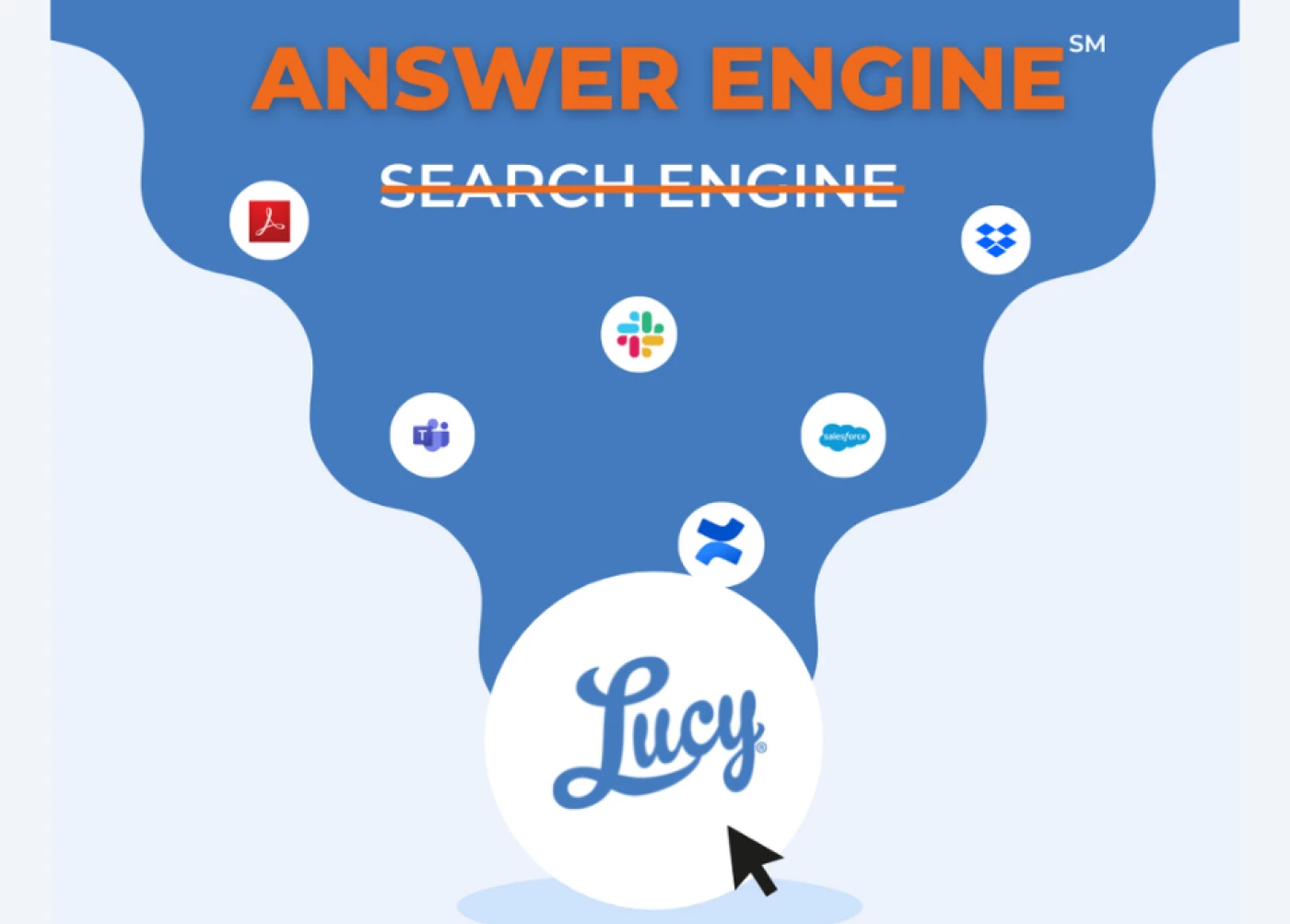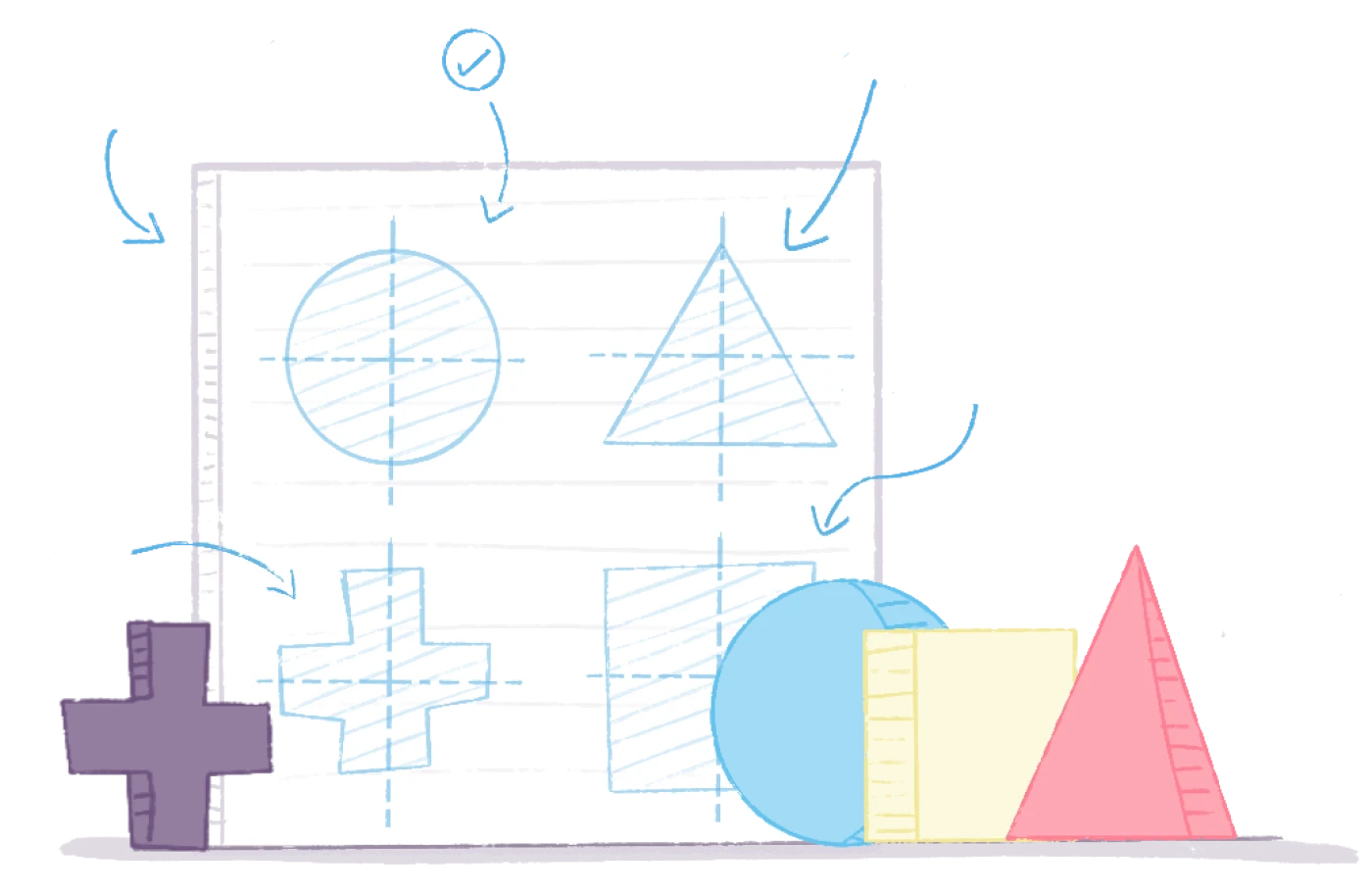Product adoption is the ultimate goal of your SaaS business. It’s how you help your users evolve from zero to hero to become product advocates who are happy to recommend your product whenever they get the chance.
High adoption rates contribute to higher customer retention and revenue growth, enabling you to create a product-led success loop with a solid base of happy customers. Who wouldn’t want that?
This is your all-inclusive guide on product adoption. We'll walk you through the definition, benefits, metrics, strategies, examples, tools, and recipes for success. Let’s dive in.
Product adoption is a process of guiding users to the habit-forming moment when they integrate your product into their day-to-day work
SaaS companies are going through some turbulent times. Focusing on product adoption might be what you need to come out as a winner
Keep your eye on the key adoption metrics to uncover adoption bugs and make improvements. We'll also explain why Kyle Poyar’s SaaS metrics 2.0 are all about adoption.
To track, manage, and improve the adoption process, you’ll need a set of tools. Find the 14 tools below that can be useful for you.
Looking for examples of successful product adoption strategies? We’ll walk you through three real-life examples and guide you through different tactics you can apply to new and existing customers.
What is product adoption? #
Product adoption is a process that starts with user activation and ends with the integration of your product into users’ workflows. Sometimes referred to as user adoption, it applies to both new users and existing customers.
To help your users reach adoption as quickly as possible, create a product adoption framework adjusted to your user personas and guide users through their journey with in-app messages.
You’re looking to personalize the onboarding process and adjust the activation milestones depending on different users’ goals, roles, and jobs to be done.
From there, you want to keep motivating users to expand their usage by showcasing the value of advanced features and guiding them on their journey of becoming product fans.
We can apply BJ Fogg's Behavioral Model to how users progress from "preview users" to "power users" through the stages of product adoption. This is what the diagram looks like.
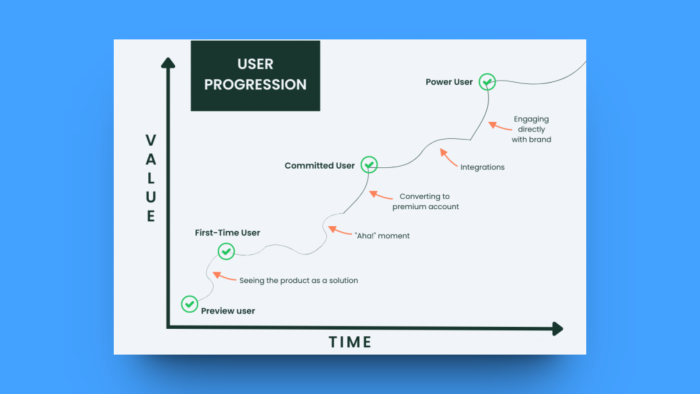
Why you should care about product adoption #
We all know how turbulent the SaaS landscape has been in the past few years. After record-high valuations and investments in SaaS companies in 2020-2021, we saw a dramatic change in 2022 due to the economic downturn.
However, it’s not all gloom and doom.
Mikael Johnsson, Co-Founder and General Partner at Oxx, a VC firm focused on investing in B2B SaaS, recently presented Oxx’s research findings – and SaaS Nordic summarized his notes.
“SaaS is still growing, but at a slower pace. Investors have a lower appetite for risk and they are more focused on profitability than the growth-at-all-costs mindset. Nevertheless, the SaaS space is still a great place to be.”
– Mikael Johnsson, Co-Founder and General Partner at Oxx
We couldn’t agree more – SaaS is a great place to be. And there are plenty of strategies you can use to drive success. In fact, focusing on product adoption can help you create a recession-proof business and conquer the SaaS winter.
By providing exceptional UX, your product will become the main lever for growth, and you’ll be able to spend less while attracting and retaining more users.
How to know whether you have a good adoption rate? Let’s go into the nitty-gritty details of measuring product adoption.
How to measure product adoption #
SaaS metrics 2.0, as explained by Kyle Poyar in one of his recent Growth Unhinged newsletter editions, are all about product adoption.
The metrics like CAC payback, LTV:CAC, and ACV are still important, of course. But in the world of PLG, Kyle notes that there’s a new user journey that the SaaS playbook should revolve around.
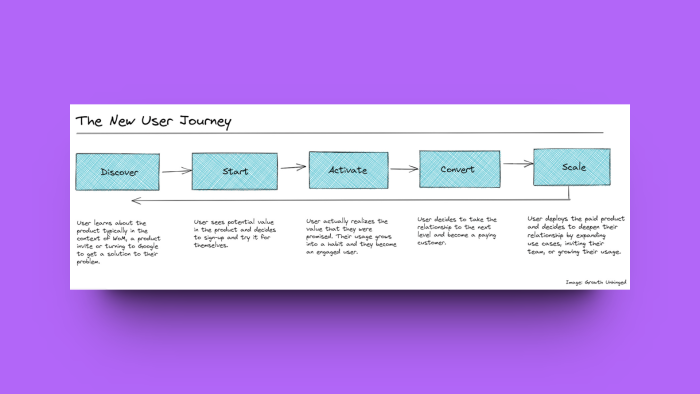
(Source)
Since product adoption is all about guiding users from beginners to advocates, here are some of the key metrics you should track.
Activation rate #
Tracking activation will help you evaluate whether users gain enough value from your app to include it in their routine. To measure user activation, you need to create activation milestones that clearly indicate a user’s activation level. This is the formula you can use.
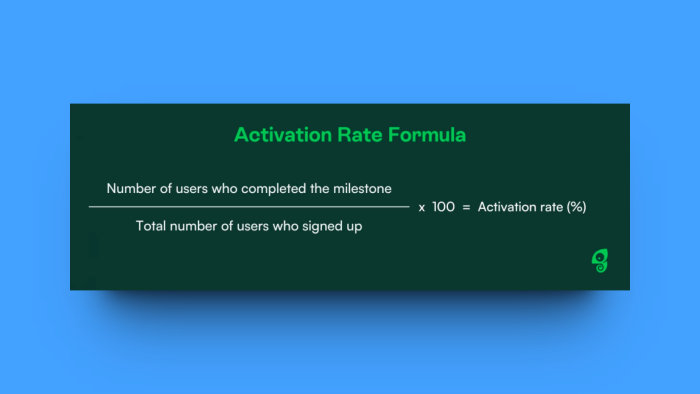
Time to Value #
Time to value (TTV) calculates the timeline from the moment new users sign up to the moment of their activation. By tracking TTV, you can identify drop-off points in the onboarding process and fix these issues before users abandon your software. And here’s how to calculate it.
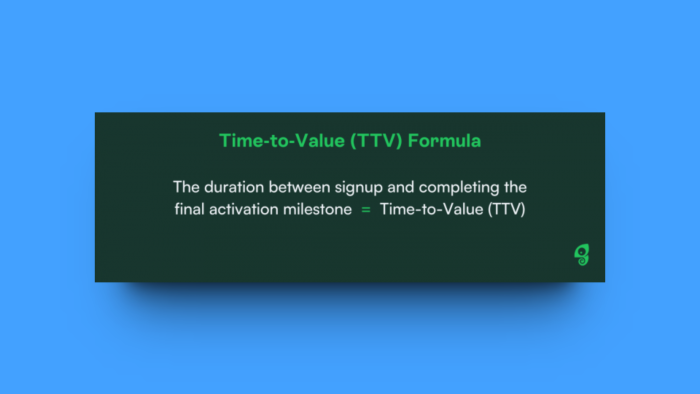
Engagement score #
This measures the overall user sentiment towards your product. Users with a high engagement score are getting great results, while those with low engagement could be at risk of churning.
How to calculate? Set up engagement events tailored to each user journey. Then, assign a value to each event on a scale of 1-10, depending on its importance. In this formula, “w” stands for the engagement event, and “n” is the number of times that event occurred.

Customer lifetime value (LTV) #
The customer lifetime value (LTV) defines the total revenue your business gains from a given customer. The higher the LTV, the more effort you should put in to attract and retain this company. You can use this formula to calculate your customer LTV.
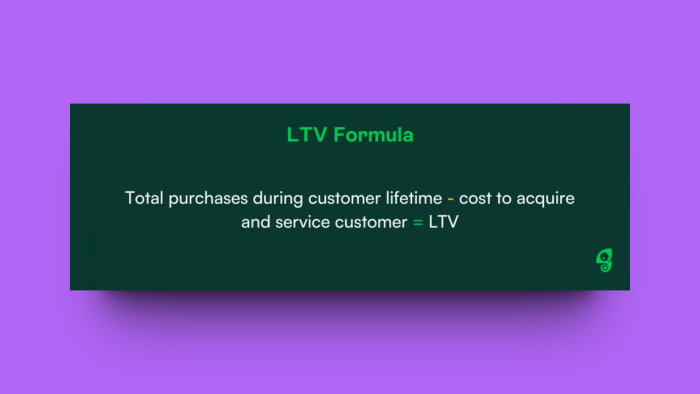
Customer retention rate #
This rate will help you understand how many users are coming back to your product regularly. From there, you’ll be able to understand behavior among teams with both low and high retention, discover what these cohorts of users are doing differently, and how to improve retention over time. Here’s the formula for you.
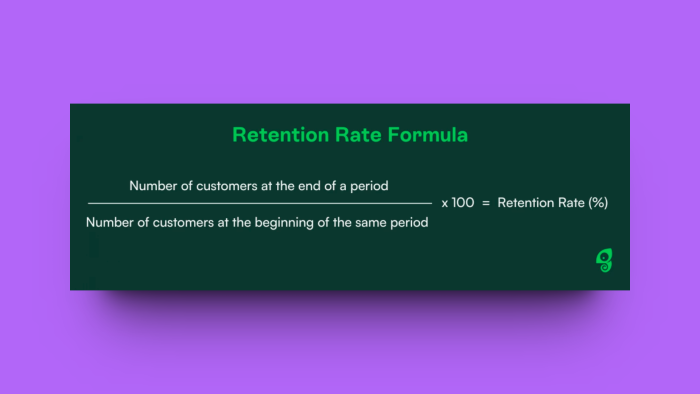
Feature adoption rate #
This is the percentage of people who became active users of a specific feature after trying it out for the first time. You can apply this to new features, core functionalities, or advanced features to see how many users are progressing towards power users in a given period.
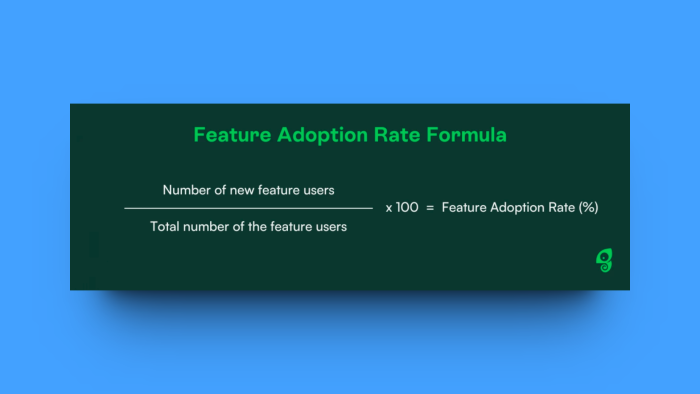
Product adoption rate #
Measuring your product adoption rate shows how many people continue to proactively use your tool to meet their needs. You can track product adoption across different timelines – daily, weekly, monthly, quarterly, or annually. And here’s how to calculate it.
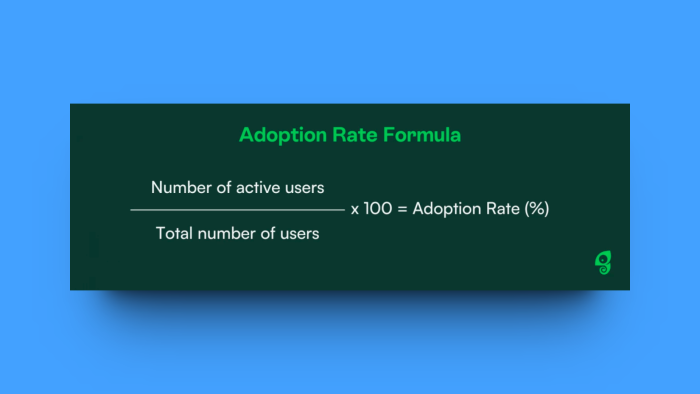
Product adoption vs. Product usage #
At this point, you might feel confused about whether product usage and product adoption are the same. They are not. And here are the key differences.
Product usage refers to data about usage frequency, breadth, and depth. It helps you understand what users are doing, how often, and for how long. To uncover this, you can use product analytics tools like Mixpanel, Heap, or Amplitude (find more on these below 👇).
Product adoption refers to the process of making your product part of users’ workflows. It adds another layer of insights on top of the usage data and helps you increase the number of loyal customers. For this, it’s best to integrate your analytics tool with a digital adoption platform.
What are the product adoption stages? #
The way your users discover, evaluate, and adopt your product will depend on your product type and user personas. However, there’s a unifying framework that's useful to know.
This brings us to the product adoption curve, developed by Everett M. Rogers as an explanation of how people adopt new technology. Rogers recognized five customer segments – Innovators, Early Adopters, Early Majority, Late Majority, and Laggards.
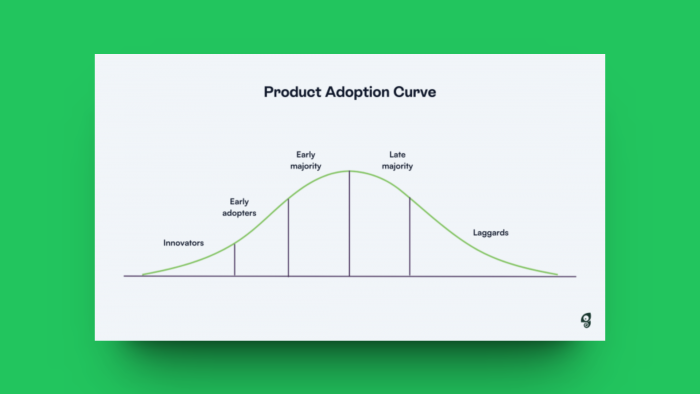
Let’s look into these five user types and adoption stages, along with what your Growth team and PMMs can do to adjust your product adoption strategy to each.
Innovators: These are the enthusiasts who are eager to try new products. They can bring valuable feedback and help you with word-of-mouth promotion. To engage them, try offering exclusive access and personalized in-app experiences.
Early Adopters: They are open to trying new solutions but need to see tangible benefits. For this group, showcase the unique value proposition, provide comprehensive onboarding resources, and offer personalized support to build trust.
Early Majority: At this stage, you’ve reached a broader user base. To encourage adoption, make sure to simplify onboarding flows and address any potential concerns. Also, social proof and testimonials can be powerful tools here.
Late Majority: Your product has now reached users who are typically more hesitant to new products. To motivate them, you can try offering premium trials and demonstrating how effective your product is with case studies. Simplified onboarding with self-serve support is also crucial at this stage.
Laggards: These users are often resistant to change and new technologies. The main reason they signed up for your product might be because “everyone else is already using it”. Here, we recommend a patient approach to adoption where you highlight the long-term benefits and show success stories from similar users.
Overall, by implementing a targeted approach, you can effectively guide users through the activation process and drive successful product adoption.
Do you have a product adoption problem? #
On their way to adopting your product, users might stumble upon obstacles that could set them a step back or even make them want to abandon your product altogether. These friction points could be a product adoption bug that you need to fix.
To know if you have such a problem, look into the low-performing metrics. Here are a few examples of user adoption issues, and what to do about them.
Low signup-to-paid rate #
If many people sign up and start a free trial, but not that many continue with a paid plan, you can try adding a one-question survey at the moment of cancellation to ask users directly why they are leaving.
You could also look into the usage data to identify the biggest drop-off moment and improve the UX at that point. Or, experiment with upsell messaging inside your app to showcase the benefits of a paid subscription at the moment of users’ highest engagement.
Low feature adoption rates #
If some of your critical features are continuously underused, try creating a step-by-step feature walkthrough to help users move forward. Add short videos and product shots to make it easier to grasp.
In case you see low adoption rates for advanced features, first make sure that users are aware of the benefits. If not, add tooltips with additional info on each feature and make their value instantly clear.
A high number of support tickets #
If your inbox is flooded with support tickets, often with recurring issues and FAQs, consider adding a self-serve support flow inside your product. You can create help menus customized to user personas, onboarding checklists, quick links to help docs, and more.
Also, be proactive with your support and announce alert issues in-app. AvidXchnage is a great example of what this could do. Their team managed to deflect 20,000 support tickets in 12 months by keeping users promptly informed in-product.
Not sure where the problem is? #
If the analytics data isn’t helping you with uncovering the adoption bug, try some more “hands-on” ways to find problems.
For example, watch session replays and look for rage-clicking. If multiple users seem to be frustrated with something, that’s your adoption issue right there.
Another useful tactic is friction logging. For this, your users will write down every step of interaction with your product and highlight anything that caused frustration. This way, you’ll clearly see the “red flags”.
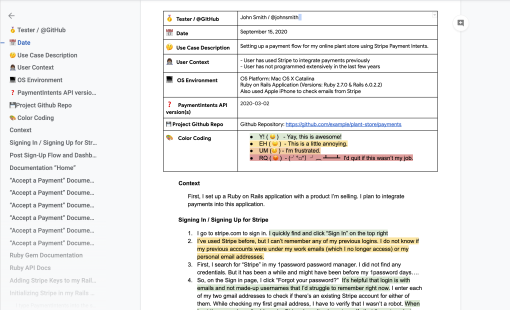
Friction Log Template
Start logging and uncovering unwanted friction in your product. Get the template straight to your inbox below👇
How to improve product adoption #
If you’ve detected some product adoption bugs and you want to make improvements, but you’re not sure where to begin, here’s some practical advice with useful tactics you can try.
3 ways to drive product adoption for new users #
Let’s take a look at a few strategies you can use to get your first-time users to their “aha!” moment and help them form a habit of using your product regularly.
1. Create amazing onboarding experiences
“No pain, no gain”, they say. But in this case, you want to eliminate all the unnecessary pain points to offer effortless gains for your users.
To delight your new users with a super-engaging onboarding flow, make it personal. Ask for feedback early on. It can be a simple question like “What are you looking to accomplish?” or “What’s your area of expertise?”
From there, create custom onboarding tours, add tooltips with additional info, and provide accessible in-app guidance that will nudge users towards accomplishing their goals.
Want to push “aha!” moments forward, eradicate friction, and tailor onboarding to user goals? Find the sweet spot in user adoption with these 9 strategies.
2. Bring helpful content into your product
New users won’t become power users overnight, but you can provide them with a superpower: easy access to your knowledge base.
Bring helpful content in front of your users and help them find the answers they need. This means pulling in all the relevant help docs, blog posts, tutorials, playbooks, case studies, how-to videos, support chat, and more.
Is there a tool for this? Glad you asked! This is exactly what Chameleon’s HelpBar is designed for. It helps you quickly add a spotlight-search option inside your product and the useful content will be just a click away from your users.
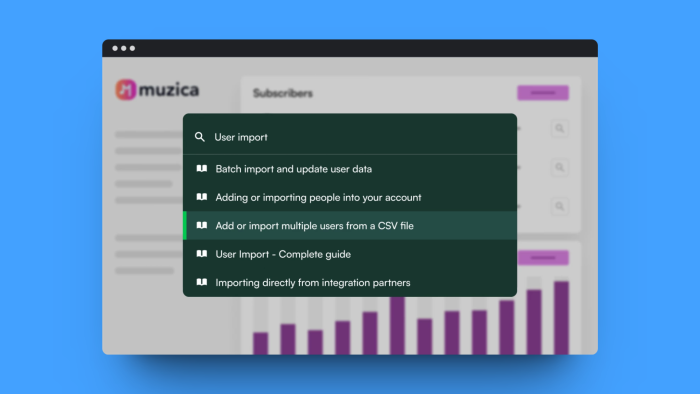
3. Continuously collect feedback
Once your new users get settled in, you can start collecting their feedback. Instead of sending a long-form survey via email, try creating a feedback loop inside your app. You’ll get to ask different questions across critical touchpoints in a user journey.
For example, you could ask “How easy was this?” after users complete an activation milestone. Or, run an NPS survey triggered after 30 days of active product usage. Or get users’ opinions on your beta feature. Or… the possibilities are endless, really!
The best part? You’ll understand user expectations and gather insights for continuous improvements, all while increasing customer satisfaction and product adoption.
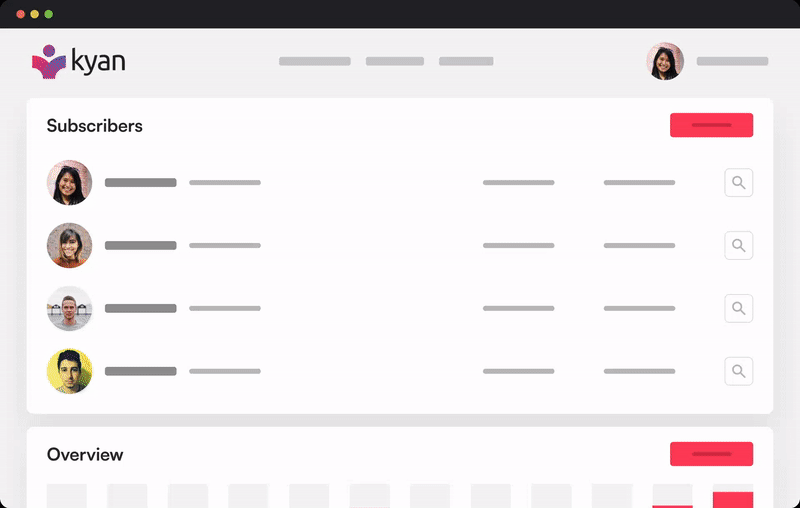
Create Microsurveys for continuous in-product feedback
Easily build no-code in-app surveys to collect contextual and targeted user feedback. Try for free.
3 ways to drive product adoption for existing customers #
Now that your users are starting to master your core features, it’s time to help them level up their expertise. Let’s take a look at some tried-and-tested tactics you can use.
1. Show the right in-app messages at the right time
Making your in-app guidance timely, contextual, and relevant for each of your user segments is essential for the adoption success. So make sure that every in-app message unlocks the next layer of value for your users.
Keep in mind that switching to a new tool might feel intimidating for some teams, so use in-app messages to help the right people get the right information, depending on their role and the job to be done.
2. Offer interactive walkthroughs for advanced features
Advanced features might require more technical knowledge or a different skill set than the core functionalities, so make sure your users are equipped with useful tips. Here, you can create interactive feature walkthroughs and guide users step-by-step through the process.
As our latest Benchmark Report shows, tours with a video have 20% higher completion rates. So, record a short Loom for each step and integrate them directly into the walkthroughs (yes, you can do this with Chameleon 😇).
3. Analyze pathways power users take
You’ve made it – you’re seeing more and more power users getting to the full potential of your product. How exactly did they get there? How long did it take? What can you do to make this time-to-full-value even shorter?
Take a deep dive into your product analytics data and group the power users into one segment, Then, use cohort analysis to uncover the details of their pathways. You’re looking for a 360-view of your power users’ progress.
Cross-reference your product usage data with customer feedback, the performance of your in-app experiences, customer health scores, and conversion rates. Then, make the necessary adjustments to help other users quickly get on the same path.
Did you know that 24% of users abandon an app after one use?
Don’t let this happen to you. In this interactive workshop hosted by Customer.io and Chameleon learn how to identify and engage users at risk, trigger upsell messages at high-intent moments, and more.
Product adoption strategy examples #
So far, we’ve covered the definition of product adoption, its benefits, key metrics, adoption stages, and various tactics for improvement.
Now, let’s take a look at some real-life examples. With Chameleon being a highly customizable product adoption platform, these are the proven strategies our customers have used to drive the adoption rates up.
Example #1: Fivetran #
While undergoing a significant UI redesign, Fivetran was looking for an in-app messaging solution they can use to gather feedback during a beta test. They chose Chameleon and quickly added a Microsurvey for user inputs.
Over 1,000 customers opted in for the beta version and almost 50 people left their feedback. This way, Fivetran was able to identify and fix 15 bugs before the official release of the new interface design.
Once the new UI was rolled out, Fivetran created a pop-up modal that announces the product update. It’s connected directly to the Tour which guides users through the benefits of the new-and-improved experience.
Read the full Fivetran case study for more details, and take a look at what the product update announcement looks like.
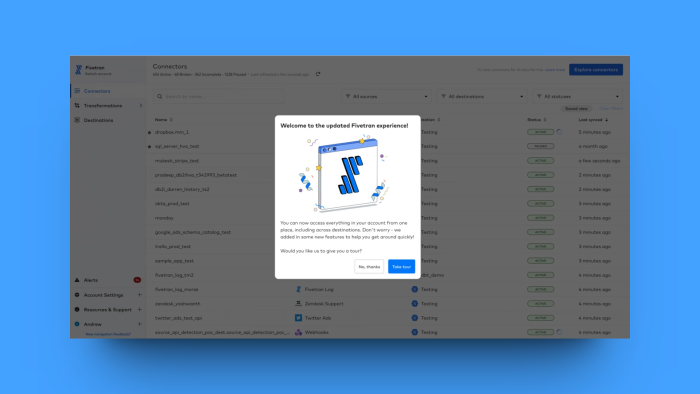
Example #2: Lucy #
Lucy’s team wanted to find a way to communicate directly with users during onboarding to reduce the number of CS-assisted training sessions. Building this in-house would burden the engineers, so they decided to try Chameleon as a no-code solution.
With Tours, Tooltips, and Launchers, Lucy was able to create step-by-step in-app guides, ensuring a smooth onboarding tailored to each audience segment. Plus, they used Microsurveys to get valuable insights for product optimization.
The results? The number of CS training sessions was cut by 50%, and users were 5x more likely to complete key actions when guided by self–serve messages. Overall, Lucy saw higher adoption and a 6x higher NPS score.
Example #3: Shortcut #
Shortcut realized there was something strange happening with their signup flow – half of the new users were dropping off at the first step. They wanted to experiment in-app to identify the problem, and they chose Chameleon for its native A/B testing feature, advanced element selection, and two-way integration with Amplitude.
Shortcut quickly launched a one-question, drop-down Microsurvey asking why users weren’t moving forward. They found out that copy was confusing, so they applied a simple copy tweak and immediately saw an 8% increase in activation rates.
It was that easy, and it was just the beginning. Shortcut’s in-product experimentation tripled with Chameleon, which ultimately helped them guide users more quickly to value.
Your product adoption tech stack #
To track, manage, and improve the process of product adoption, you’ll need a set of tools for product analytics, experimentation, feedback collection, in-app messaging, customer communications, and more.
Let’s look into 14 tools you can use for different areas. Some of these might already be a part of your tech stack. If not, the best way to choose the right fit is by looking into how well it integrates with your existing tools.
Product analytics tools #
Mixpanel
Mixpanel helps you track user interactions within your product. Use it to collect activation, engagement, and retention data, build custom reports, and take a deep dive into user behavior. Here’s an example of activation, frequency, and onboarding charts.
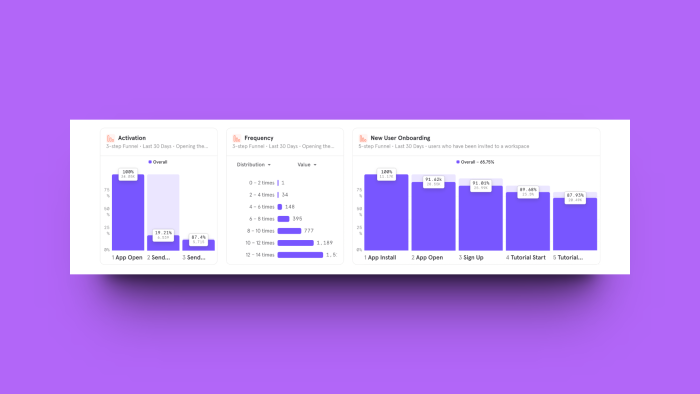
(Source)
Heap
Heap gives you a full overview of your customer journeys and helps you track conversion, retention, and user experience across devices. With Autocapture, Heap will automatically track every click and action your users perform, but you can also get insights from session replays, heatmaps, journey maps, and more. Take a look at Heap’s Autocapture in action.
Amplitude
Amplitude is a product analytics tool that you can use for customer data collection, audience segmentation, and seamless targeting. Whether you want to run A/B tests or build audience lists to personalize flows, Amplitude can be a powerful tool for your team. For example, here’s what a Product and Marketing Dashboard looks like.
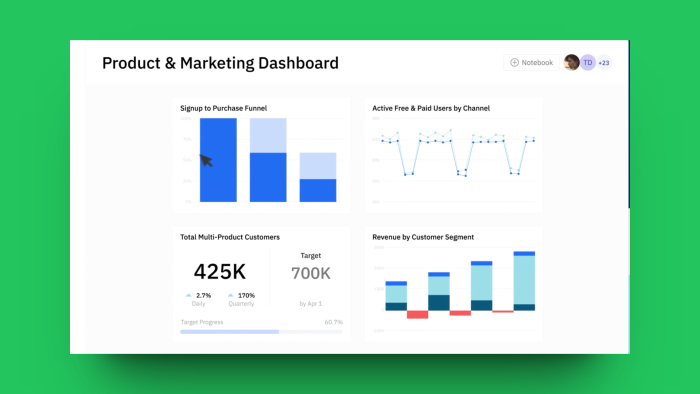
(Source)
In-app messaging software #
Chameleon
Chameleon is a customizable product adoption tool you can use to create interactive Tours, Tooltips, Microsurveys, Launchers, and other forms of in-app messages.
Use it to personalize onboarding flows, announce feature updates, and offer in-app guides. This can help you decrease time-to-value, reduce overall churn, and increase upsells to premium plans.
Once you sign up, you’ll enter a sandbox environment called Playground, and here’s a quick overview of the first steps to take.
Appcues
Appcues is an in-app messaging platform that helps you personalize user experience within your web and mobile applications. It also offers an analytics feature, allowing you to identify areas for improvement and optimize the UX.
You can use Appcues to design and deploy walkthroughs, modals, and engagement campaigns to guide users through key functionalities. Here’s an example of a welcome Tour built with Appcues.
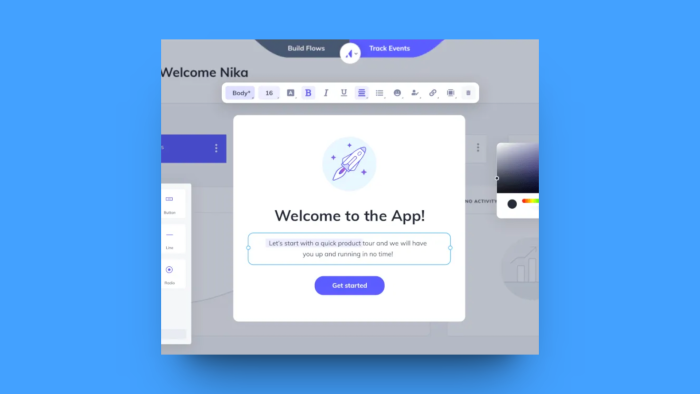
(Source)
Experimentation solutions #
VWO
VWO is an A/B testing tool for optimizing digital experiences and maximizing conversions. As your customer expectations change, you can test different campaigns, optimize your product messaging, and create omnichannel experiences. Here’s a mockup example of an A/B test done with VWO.
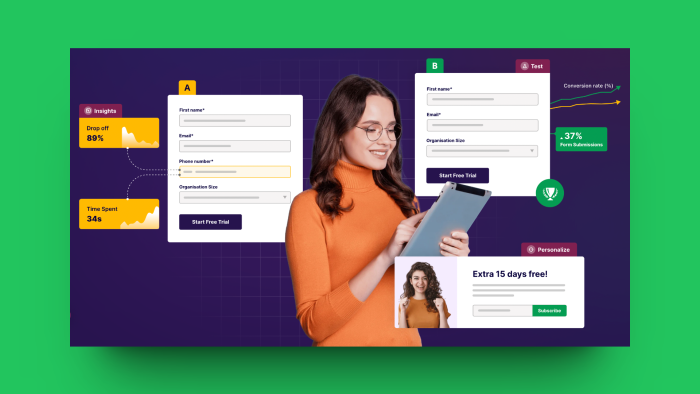
(Source)
Mutiny
Mutiny helps you turn your website into an experimentation field. Integrate it with your CRM, sales, and marketing tools to identify web visitors by their industry, company size, or funnel stage. Use its AI feature to craft hyper-targeted copy for modals, slideouts, and banners, or to make dynamic text changes on your web pages.
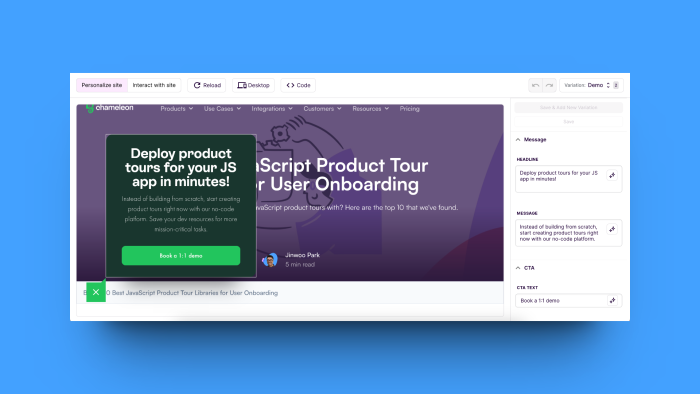
Feedback tools #
Typeform
Typeform is a feedback platform with a suite of tools. Its core product – Typeform – helps you get feedback through forms, surveys, or quizzes. With VideoAsk, you can create short video questions, while Typeform Labs helps you make AI-enabled innovative conversational interfaces.
You can get started quickly by using one of the Typeform templates. For example, here’s the Beta Product Feedback Survey template.
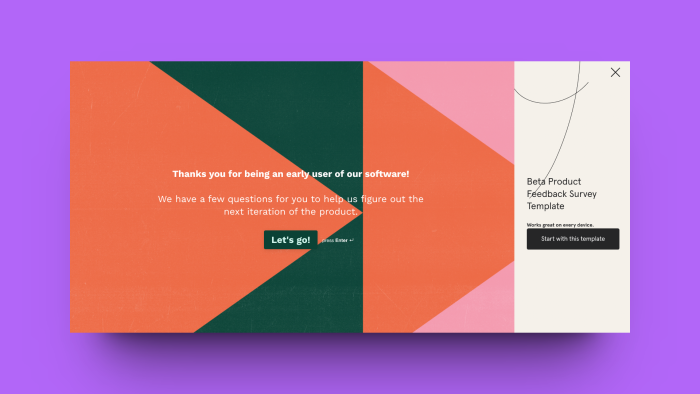
(Source)
SurveyMonkey
SurveyMonkey is an online survey tool that helps you collect feedback from product users, website visitors, email subscribers, and others. With the free version, you can send an unlimited number of surveys with up to 10 questions. And here are some of the templates available in the SurveyMonkey library.
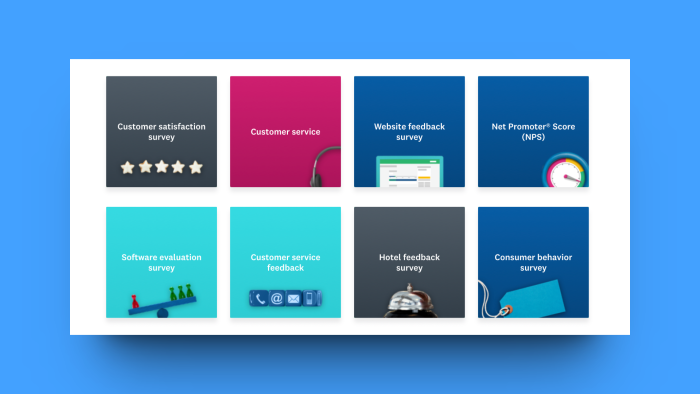
(Source)
Delighted
Delighted enables you to schedule ongoing surveys triggered by time intervals or custom events. With its multi-language support, you can localize your surveys to 30+ languages. Plus, you can use AI-driven analytics for real-time reporting and automated calculation of NPS, CSAT, and other scores. For example, here’s what a CSAT survey could look like.
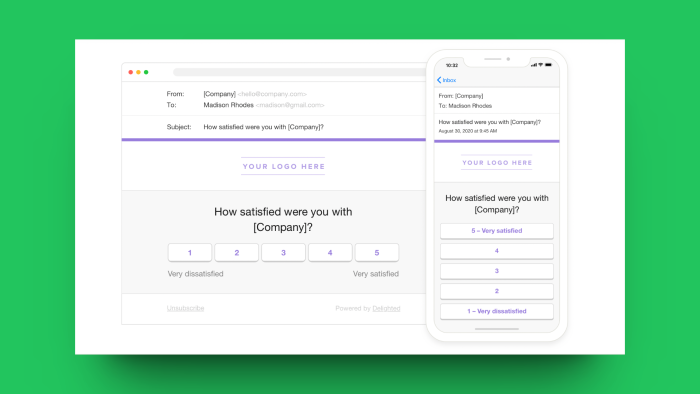
(Source)
The best way to collect relevant, contextual user feedback is by asking a simple question at the right time, in the right place. You can do this with Chameleon’s Microsurveys by building a continuous feedback loop into your in-app messaging framework.
Customer success solutions #
Front
Front unifies your email, chat, and other communication channels. It provides features like message assignments, internal comments, and shared drafts. Use this tool to optimize workflows and improve response times. Here’s an example of support inbox in Front.
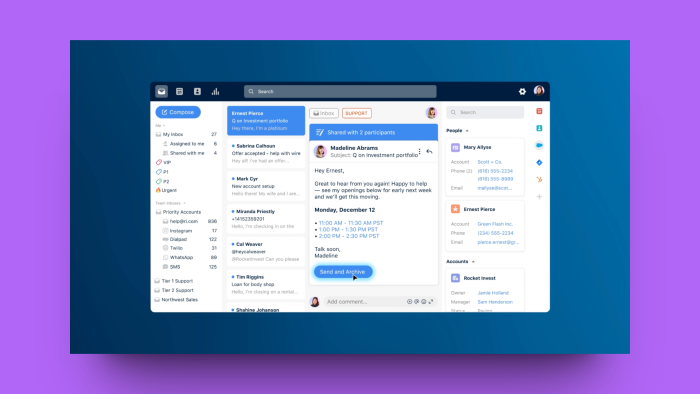
(Source)
Intercom
Intercom offers a comprehensive solution for customer support across email, SMS, and other channels. You can also create help docs and tutorials by using its integrated knowledge base.
With Fin, Intercom’s AI chatbot, you can resolve issues faster while reducing team workload. Here’s an example of Fin in action.
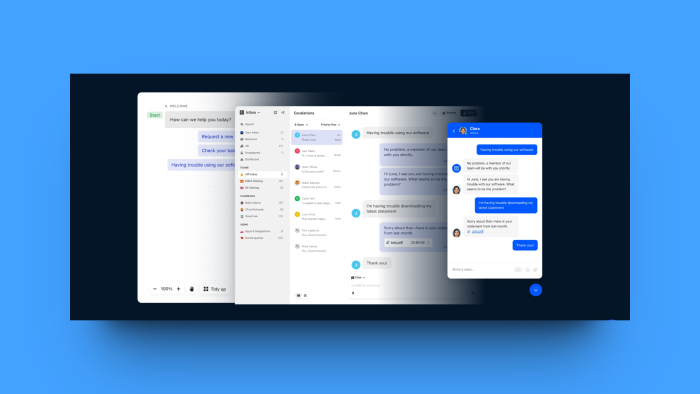
(Source)
Marketing automation tools #
Customer.io
Customer.io is a customer engagement platform for creating email campaigns, in-app messages, and mobile notifications throughout the customer journey.
You can segment users based on various attributes and behaviors, and trigger automated welcome emails, onboarding sequences, re-engagement messages, and more. Here’s an example of the automated welcome email sequence.
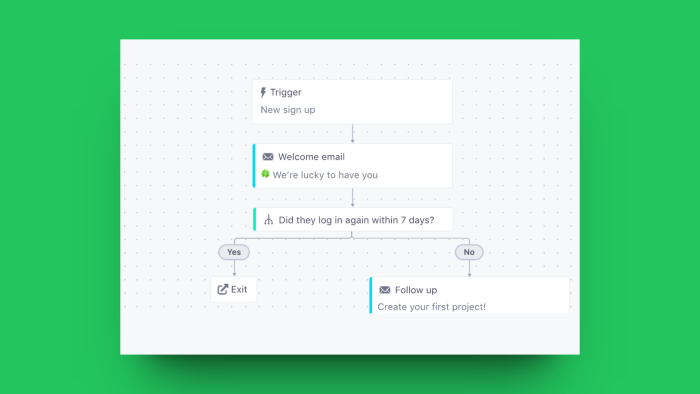
(Source)
HubSpot
HubSpot is a CRM platform that serves as a centralized database and enables you to nurture leads, manage sales pipelines, and collaborate effectively across your team. You can do a lot more with a suite of tools in the Marketing, Sales, Customer Service, CMS, and Operations hubs. For example, this is what a lead management flow could look like.
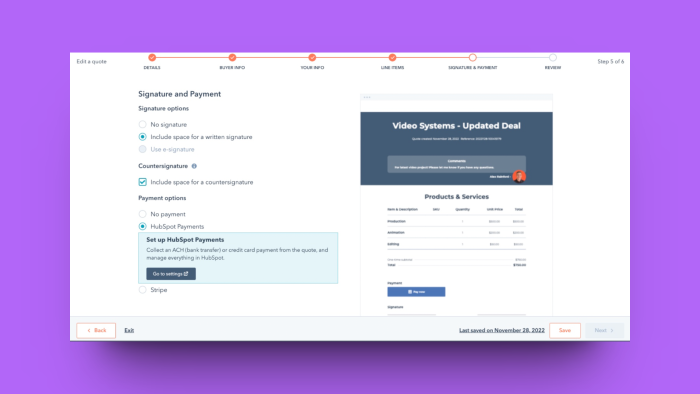
(Source)
How Chameleon helps with product adoption #
Let’s wrap things up with a short summary of what we covered here, and the ways using a purpose-built product adoption platform like Chameleon can help you take control over your product adoption without putting a burden on your engineers.
To recap, product adoption happens when a user identifies the value of your product, starts using it actively, and adopts your product as part of their day-to-day workflow.
Here are the steps for adoption success:
Create a product adoption framework adjusted to your user’s goals
Track important adoption metrics with your product analytics tool
Integrate with an adoption software for a complete overview
Guide users in-app with onboarding tours, feature announcements, advanced how-to guides, upsell and cross-sell messages, and more
Find adoption bugs and areas of the user experience that you can improve
Continue to nurture customer relationships through every touchpoint, across multiple channels, and motivate new users to become power users
Finding the right tools and integrating them with your tech stack is crucial. Look for the tools that offer advanced, two-way integrations you can leverage for deep insights.
Want some recipes for success? Browse through our Recipes library to find step-by-step guides on how to level up your product adoption game by using Chameleon together with other tools.
Here are a few ideas:
👍 Enable on-demand onboarding with Intercom, Zendesk, and Chameleon
🚀 Drive adoption of sticky features with Customer.io and Chameleon
🤝 Increase trial conversion using Heap, Chili Piper, and Chameleon
📈 Trigger behavior-based upsell modals with HubSpot, Mixpanel, and Chameleon
Remember, growing the number of power users will take time. But once your users become genuine fans, they will advocate for your product wherever they get the chance – resulting in higher acquisition, retention, and revenue rates for your SaaS business.
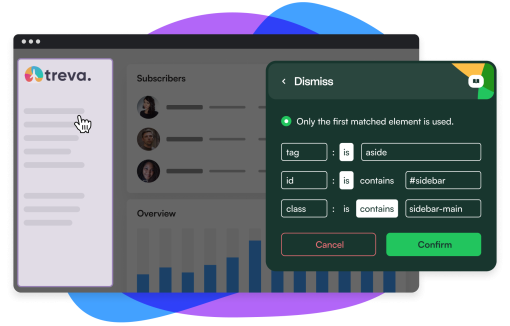
Build Your Product Adoption Flywheel in Minutes
Put rocket fuel into your product adoption with Chameleon's no-code UX builder

